In the ever-changing world of SEO, one thing remains constant: search engines are using entities to better understand content. Google has made it clear that they are focusing more and more on entities, and the concept of entity density is one of the new ways an
SEO tester can look to rank higher in their search engine. We will discuss what entity density is, how to calculate it, and how you can use it to improve your website's ranking. We will also provide a handy
entity density calculator so that you can easily determine the entity density of your own website or your competitions.
Entity density is the number of
entities (people, places, organizations) that are mentioned on a webpage. It is calculated by dividing the total number of entities mentioned on a page by the total word count. The theory is that the higher the entity density, the more "important" Google perceives your page to be.
Calculating entity density is relatively simple, but you will need to have a list of entities that are mentioned on your web page. Once you have this list, take the total number of entities and divide it by the total word count of the page. The result is your entity density score.
Using this calculator is pretty simple. You'll need a SEO tool that will help you determine the number of words that are on a page and the number of entities that are used. When determining the number of entities used, you are looking for the total number, not the number of unique entities.
Once you have those numbers drop them in the calculator and get the entity density percentage.
We suggest that you do this for the top 5 competing sites for your keyword, though doing the top ten wouldn't hurt. Bare in mind, the idea of entity density as a measure of topical relevance is still new and while a lot of SEO's are optimizing content with entities, not many have even considered looking at density of entities as a measure of comparison. It does, however, stand to reason that the content that is more "on point" for the topic should win (if
backlinks didn't matter so much).
To determine the average density for the top five ranking pages, or your chosen top 5 competing pages, use the calculator below. You can fill in the fields as you work through your list with the entity density calculator to save you some time.
By increasing the entity density of your web page, you can make it more "understandable" to Google and potentially help improve your rankings. Here are a few tips for improving your entity density:
• Utilize
schema markup to further emphasize the entities on your page. This will help Google understand the context of your content better.
• Use synonyms for entities instead of repeating the same word or phrase over and over. This will help increase the entity density of your page, as well as make it more readable for readers.
By following these tips and increasing the entity density of your web page, you can improve your SEO and help increase your ranking in Google search results.
Entity density is potentially an important concept to consider when optimizing for SEO. By understanding what entity density is, how to calculate it, and how to use it to improve your SEO, you can run tests to see if it will help your website rank higher in Google search results. Try using our entity density calculator in conjunction with your other no-page
SEO tools today and see what kind of difference the insights make in your campaigns!





